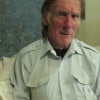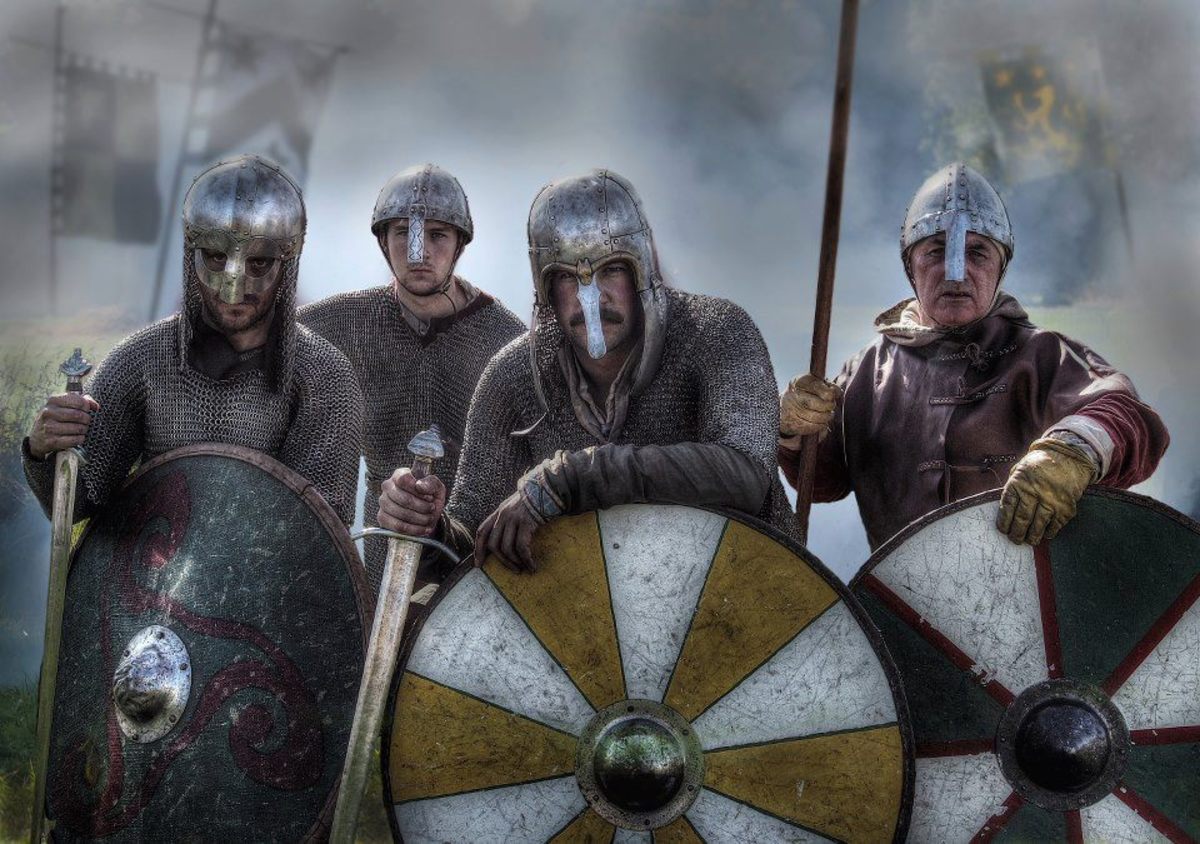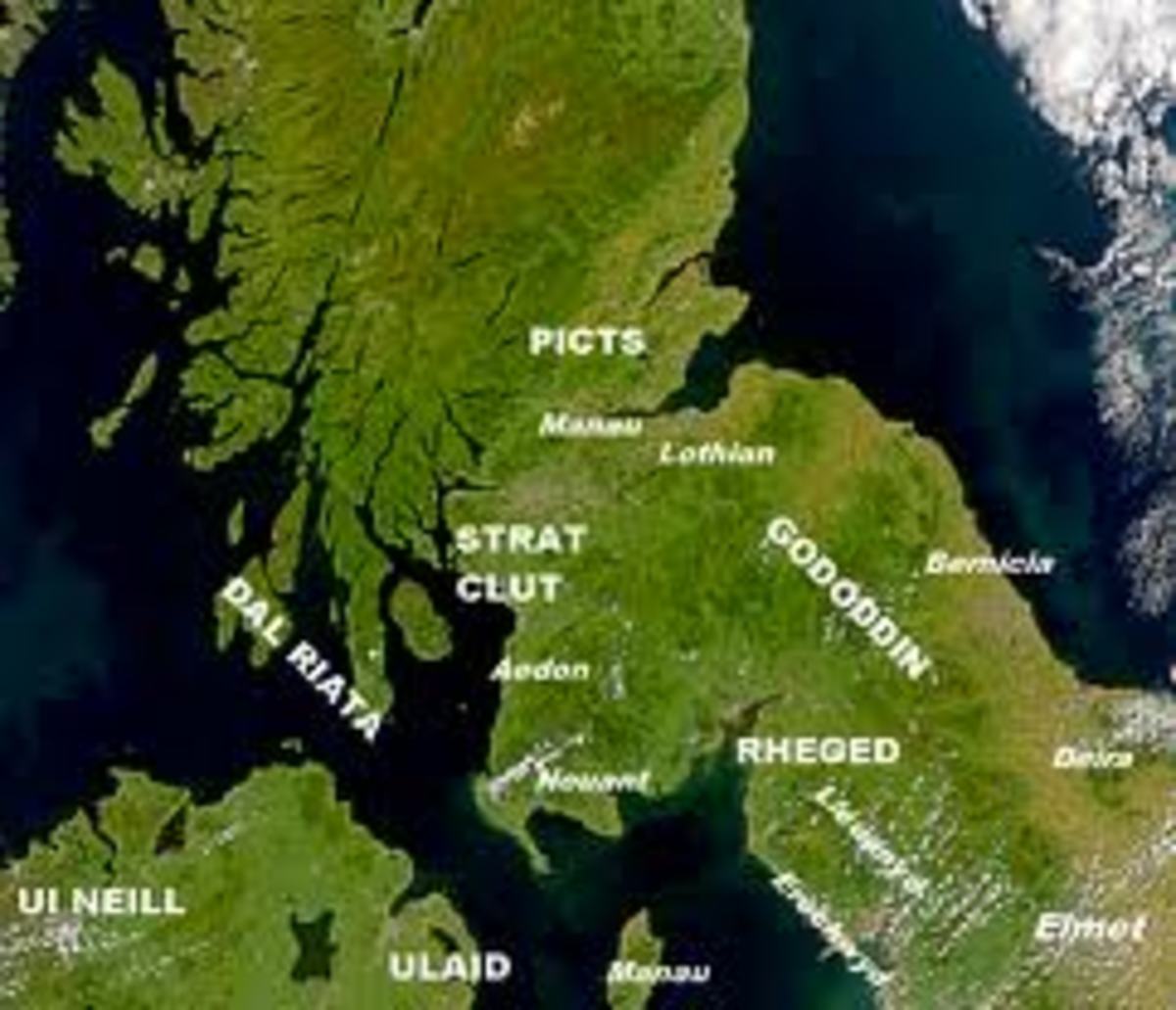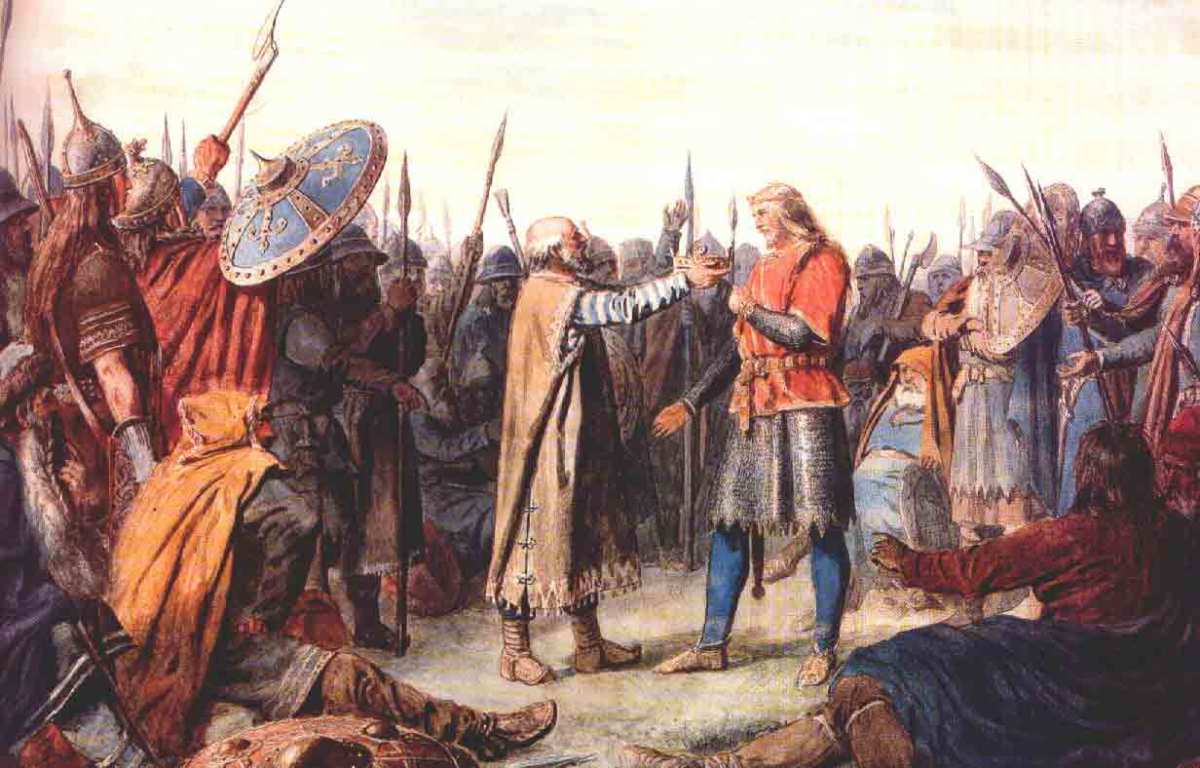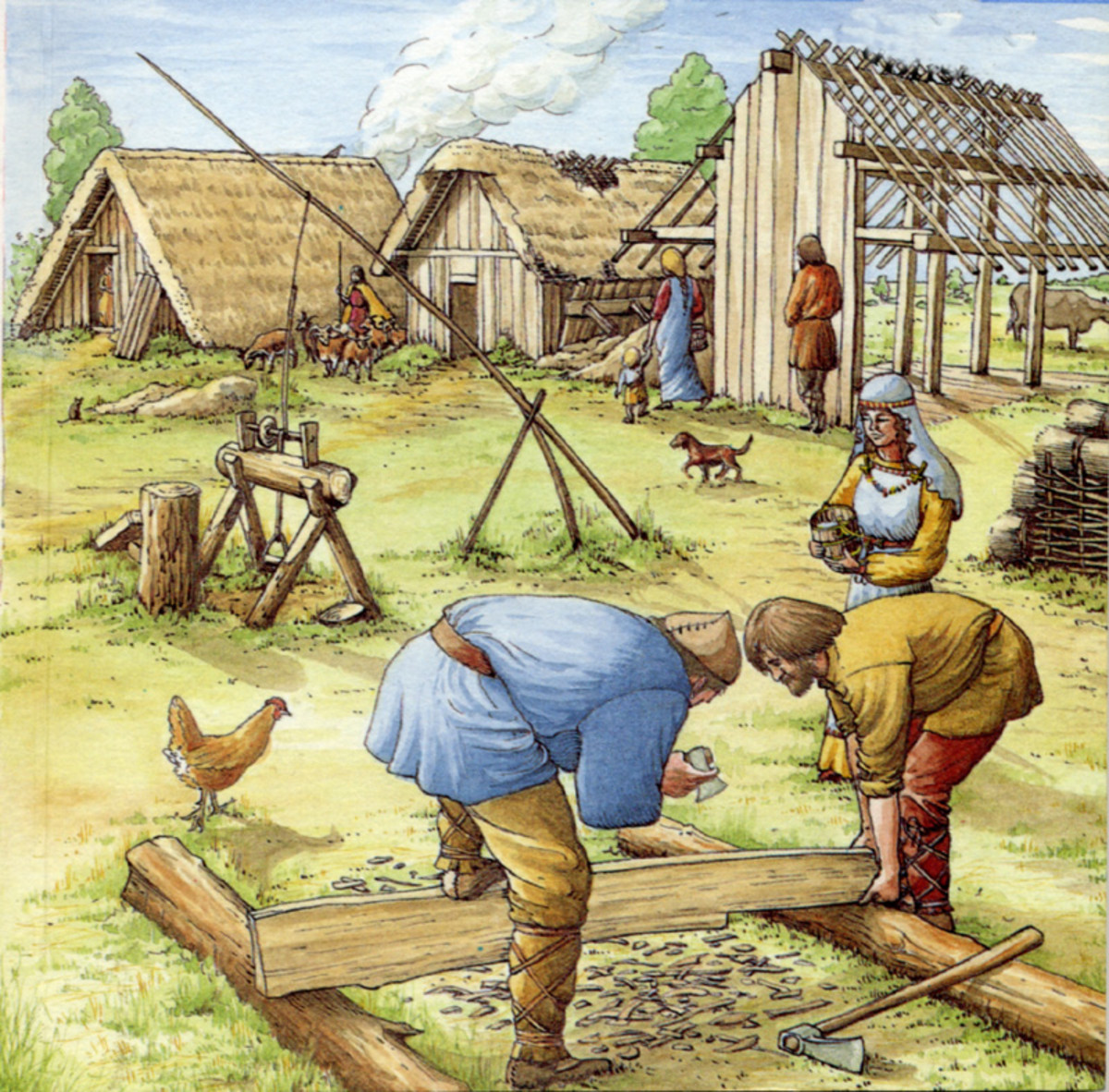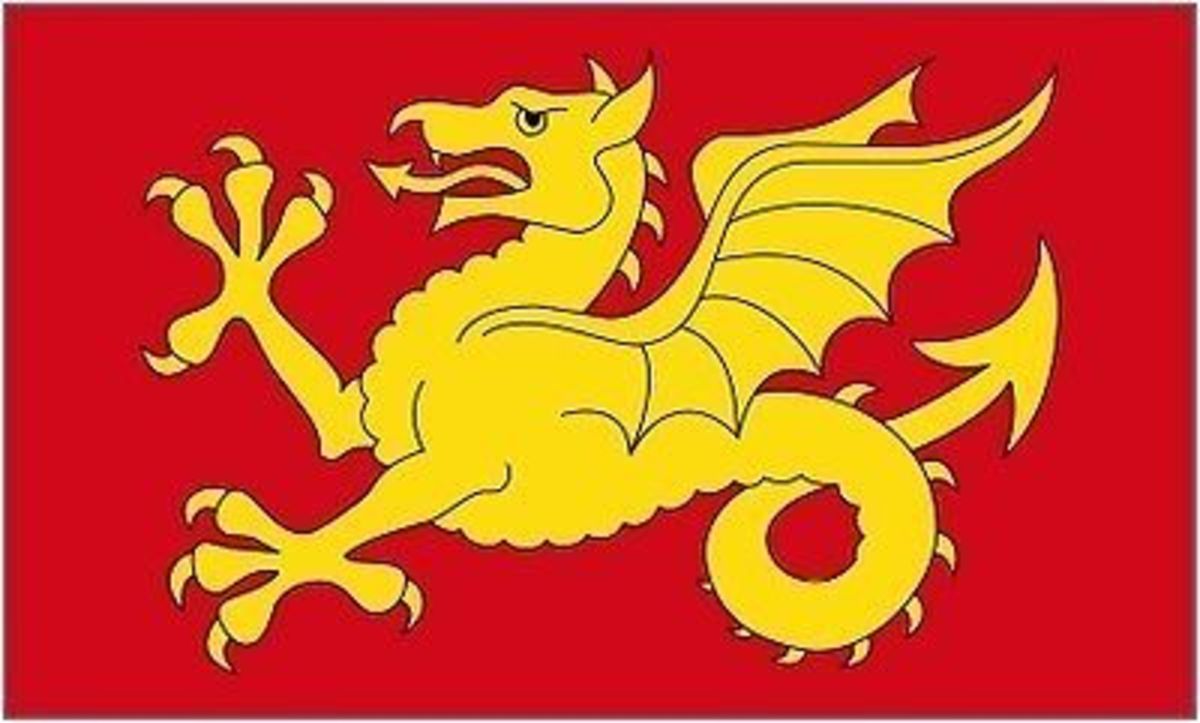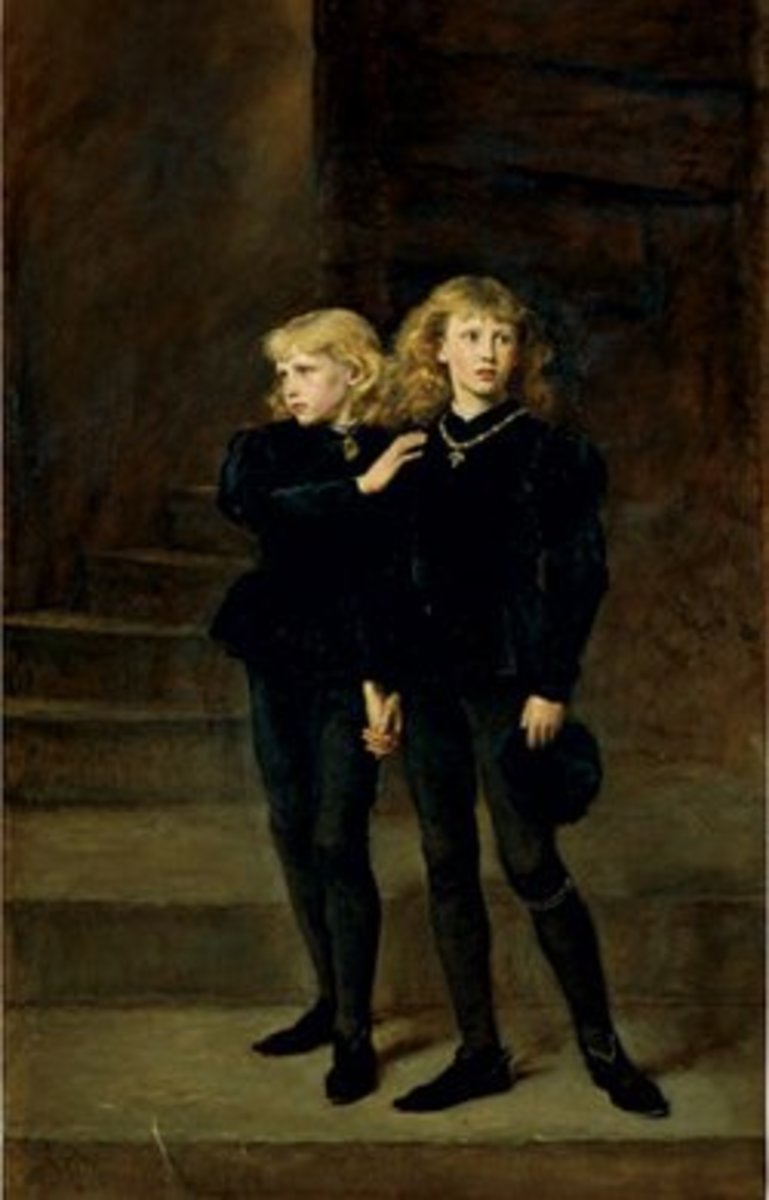- HubPages»
- Education and Science»
- History & Archaeology»
- History of Europe
Northumbria - 2: The Beacon Flares - Second Conversion, Oswald and Oswy to Aeldfrith
"What is this ground called?" Oswald asks, taking in the land around that rises toward the chisel-shaped hill and its crest.
"My Lord King, it is the Hefenfelth", comes the answer from an underling.
"Then our men will have gone straight to heaven on behalf of the kingdom", Oswald smiles. "And my heaven is Penda's hell".
Tired laughter follows, Oswald's warriors weary from the hard fighting. Hexham is close by, it's hearth fires welcoming. With the Miercan king routed peace will come to the kingdom again, if only for a few years...
Return of the king...
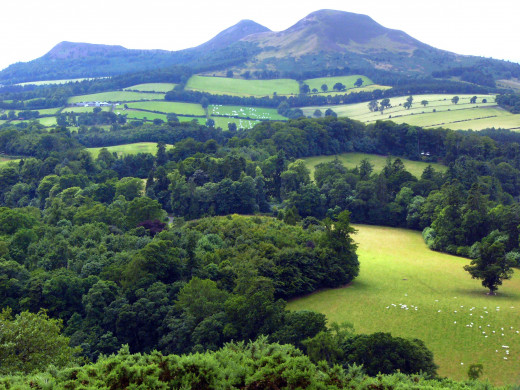
A change was in the air, winds blew ill for the newly converted. Decisions would have to be met...Bow to your wyrd or let it take you the hard way!
Aethelfrith's crowning as king of the Northanhymbrans signalled to those who had taken the cross that they would be wise to forsake their new beliefs. He had no time for a faith that foreswore the old gods and preached brotherly love toward those who wished him evil. However Aethelfrith's reign would be cut short. Oswald and his younger brother had fled the kingdom at his accession and were given hospitality at the Scots' mission on Iona. Their return spelled a new beginning for the North. Oswald's kingship was not questioned in Northanhymbra. It would not be long before his overlordship over Rheged, Mierca, West Seaxe and the other kingdoms became a reality. A fair man, this Bretwalda was no tyrant, nor did he harbour grudges.
So now Oswald was over-king of all Aengle, Britons and Gaels in these isles. Oswald attributed his win to his new beliefs. He had talked his men into praying before the fight, and defeating the greater numbers of Miercans and Britons convinced him of the validity of his conversion.
Set on spreading Christianity across the North-east he drew the Gaelic monk Aidan from iona to further his cause. The Celtic form of belief system, being significantly at odds with the Roman form promoted by Eadwin and Paulinus, this would later bring problems to the kingdom. Aidan opted to found a very basic monastic establishment in the style of iona on Lindisfarne off the coast of Beornica (near Bamburgh), becoming its first bishop.
In AD 640 a new monastery was founded on a headland (at Hartlepool) by Hieu, a Gaelic princess. The nature of the rocky promontory it was built on made it almost inaccessible. Two years later Oswald had work carried out on the minster church at Eoferwic. To the north-east of Eoferwic another ecclesiastical house was founded by another monk, Ceadd (at Lastingham near Kirkbymoorside, Pickering). Less well known was the monastic foundation of the 'Goat's Head' (Gateshead, overlooking the Tyne), the interpretation of Bede's name for the location, written in Latin as 'Ad Caprae Caput'. By AD 653 this site was headed by an Anglian abbot known to us as Uttan. The name 'Goat's Head' is said to have emanated from a Roman figurehead mounted on a post on the Roman military bridge that spanned the Tyne for access to Hadrian's Wall.
Oswald's power-base grew irrespective of the Christian slant his government took. His sights were set on Lothene. Dinas Eidin (or Din Eidyn), erstwhile main stronghold of the Gododdin was besieged and taken in AD 638, given its Anglian name of Edinburh, 'Edwin's stronghold'. Many settlements in the region still bear their Aenglish names, the form of the language owing its origin to that of the Northanhymbran dialect of Aenglish. The older Pictish or Brythonic language links were broken henceforth. Nor did the Gaelic form of language take on, although after the Northanhymbran defeat at Nechtanesmere Edinburh would be known as 'Dunedin'.to the new masters.
Peace would not last long. Oswald - like his forerunners - would not die in bed! Penda drew him too far south beyond the bounds of Deira to be within reach of help in August, AD 642. In the western midlands, not far from Welsh territory at Maserfelth (Maserfield) Penda rounded on him and with superior numbers crushed Oswald's Northanhymbrans. A different fate awaited Oswald from that of his men on that 5th August. He was tortured after watching his few remaining men slain before him. His remains were found bound to a tree, giving light to a legend about his martyrdom.
.
Oswald's grisly fate leads to Oswy's rise to power
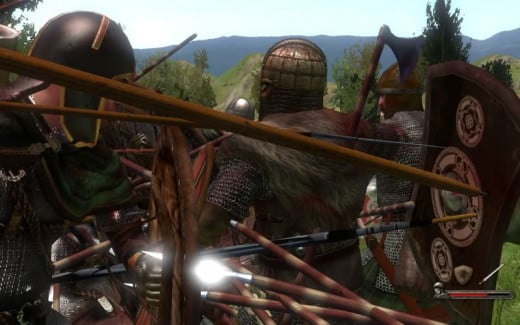
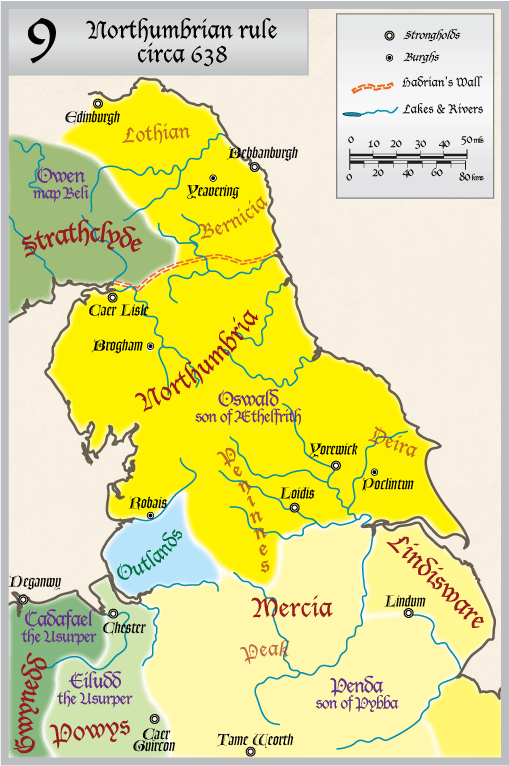
Beornica saw Oswald's younger brother Oswy on the throne. South of the Tees in Deira a new name arose, Oswin. Again the kingdom was split asunder, weakened - a magnet for Penda, who took the lands south of the Hymbra, southern Deira and in the western area of Elmet around Loidis. So, threatened whichever way he looked but from the sea, Oswin had no hope of surviving the first year of his 'reign'. He was cut down after backing away from fighting Oswy near Catraeth (at Wilfar's Hill). Hiding nearby at Gilling West Oswin was found by one of Oswy's men and slain there and then.
Now with the crown of Deira he founded his claim to the kingdom on his marriage to Eadwin's daughter Eanfled. With Northanhymbra whole again Oswy pinned his sights further afield. However he had to set things straight again in his own kingdom when his nephew Aethelweald - to whom Oswy had entrusted the running of his affairs in Beornica - undermined his authority by siding with Penda when the Miercan king once again took advantage of the kingdom's weakness. Aethelweald had his sights on the crown, perhaps, but Penda would use him to his own ends and reached Baebbanburh in AD 653. The story goes that after some two years of warring Oswy gave Penda and his Wealsh allies treasure from his own storehouses in order to dissuade them from pillaging the land. The sop worked and, with his allies homeward bound with their share of the loot, Penda was left prone in the rains of that autumn, AD 655 his packhorses laden with treasures. Hard on his heels were Oswy's men. By the River Winwaed to the west of Loidis (see AGE OF HEROES - 11: FOOL'S GOLD) they caught up with him. With the river in full spate from Pennine rains Penda stood no chance and was slain with most of his men. Some escaped with some of the gold and silver. What happened to Aethelweald is left to the imagination, but he would not have been a pretty sight to behold.
Now Oswy was 'Bretwalda', acclaimed over-king as others would be before and after him. He set Penda's son Peada on the Miercan throne with his lands north of the Treonta (Trent) forfeit to Oswy and his successors.
This defeat of Penda led to a new era of Christian development in the north. New ecclesiastical houses such as at Aet Hripum (Ripon) by Gaelic monks from Melrose, and Oswy's sister Hilda was financed to establish a monastery at Streoneshealh (Whitby) on the cliff overlooking the River Aesc (Esk). Debate arose about the nature of Christianity that should prevail in the kingdom of Northanhymbra. Gaelic aescetics were balanced against Rome's classical form of Christianity. Oswald and Oswy, having been sheltered on Iona opted for the Gaelic Celtic form and Eadwin's Roman foundations were swept out... for the time being until AD 664 when the Synod of Streoneshealh was held to discuss the timing of the Easter Festival. For the Celtic cause were Colman of Lindisfarena, Hilda of Streoneshealh and Ceadd the Bishop of the East Seaxne at Colneceaster (Colchester). The far-travelled Wilfrid stood for the Roman belief and talked Oswy into turning his back on the Celtic Church.
Bishop Colman of Lindisfarena bowed out and left for iona, to be replaced by Tuda. Roman ways were ushered in 'through the back door' by Tuda. His office was short-lived, the plague taking him later in the year. A condition of Wilfrid taking Tuda's bishopric was that he could move his see to Eoferwic in a bid to distance himself from the Celtic 'ghosts' of Aidan and Colman. Wilfrid doggedly followed Rome's diktats and, claiming no-one in Britain could properly consecrate him as bishop he crossed to Frankia to undergo the rite as practiced there. Angered, Oswy had Ceadd of Lastingham ordained in the Celtic manner to step into the absent Wilfrid's shoes in his absence. He was not going to stand for Wilfrid's pedantic purist Roman ways. .
Revenge on Penda by the icy waters of the Winwaed
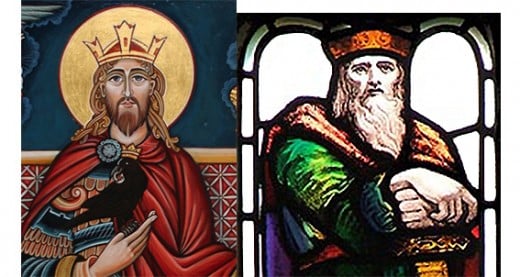
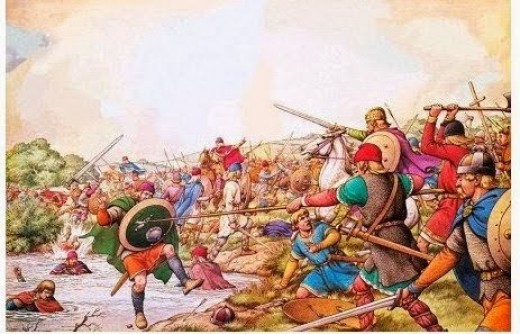
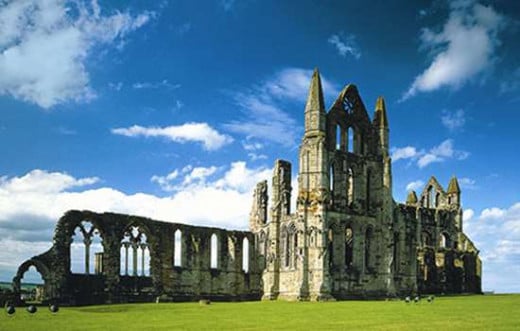
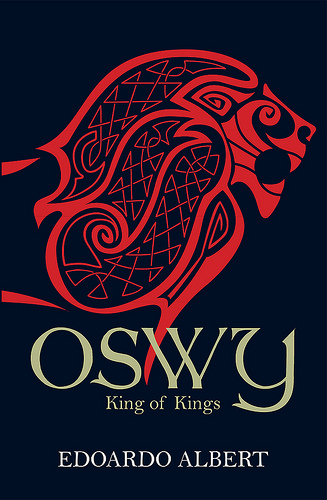
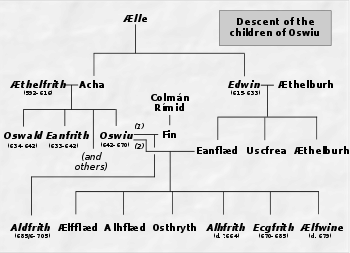
Ecgfrith and counter-reform
The first thing Oswy's son Ecgfrith did on succeeding to the throne in AD 696 was to bring back Wilfrid, allowing him to take up his post as Biscop Ebor (Bishop of Eoferwic). Saint Peter's grammar school, not the present fabric, was founded by him to teach the king's sons and those of the nobility in the ways of a distant Roman Church.
Against these ecclesiastical changes Northanhymbria waxed under Ecgfrith. Southern Rheged and Dumfries felt the weight of his presence, as did the Highland Picts by AD 672. The following year saw the Miercans defeated. Northanhymbra's star was on the rise. Yet Ecgfrith's personal horizons would change radically. He divorced Aetheldreda of Elige, his wife of East Aengla descent to wed a more worldly Ermenburga. Wilfrid encouraged Aetheldreda to take the veil and she was given land at Hexham by her ex-husband. Aetheldreda however donated the land to Wilfrid to build a monastery and she herself founded a new house at St Abb's Head on the coast east of Edinburh.
Around this time - AD 674 - saw another new Roman Christian monastic house founded at Monkwearmouth (near Jarrow) by a Northanhymbran nobleman who went by the name of Benedict Biscop on land given by the king. In time this would become a renowned educational centre with a large librarium, a prominent pupil being a youngster from amongst the common folk named Bede. Books would be brought from Frankia and Rome. The first panelled picture glass would be introduced here by European glaziers and a new form of monastic choral chant introduced to the Roman Church by the Pontiff Gregory. Facets of rite and ceremony unheard of this side of the English Channel were applied under the auspices of Biscop.
Wilfrid now began to anger Ecgfrith, as he had done his father and in AD 678 the man was exiled from the kingdom. Was Ecgfrith annoyed at the close relationship Wilfrid had built with his former wife? Wilfrid's bishopric was split in two, with a see each at Eoferwic and Hexham, the latter now reaching from the Tweed to the Tees. Eoferwic's see would now span the land between the Tees and the Hymbra.
Smarting at what he saw as an affront, Wilfrid would try to sneak back into the kingdom through Dunbar. He had been occupied with the conversion of the peoples of the Low Countries, important enough to his masters in Rome, but he hankered to be back in his own surroundings amongst those he understood. At Dunbar he was halted with documents in his possession to overturn the king's instructions. Ecgfrith did not see himself subject to Roman edicts and in AD 681 further halved the Bishopric of Hexham, with Lindisfarena playing a renewed part in the Northanhymbran Church. Hexham now found its bounds marked by the River Alne in the north and the Tees in the south, Lindisfarena's extending to the Forth and St Abb's Head. Wilfrid himself was interred on his return to Britain, and on managing to escape fled to the South Coast to undertake missionary work amongst the Suth Seaxne.
A campaign by Ecgfrith in Ulster in AD 684 came to nothing, Cuthbert had tried to dissuade the king from over-extending. Highly acclaimed in the kingdom, his influence extended beyond the Church and Ecgfrith moved to have him elected as Bishop of Hexham in AD 685 at a synod near Alnmouth in order to protect the old man from the elements on the wild islands. But Cuthbert would have none of it, so consecration to Bishop of Lindisfarena went ahead at Eoferwic,on April 7th with Ecgfrith in attendance.
Ecgfrith, a light stubbed out
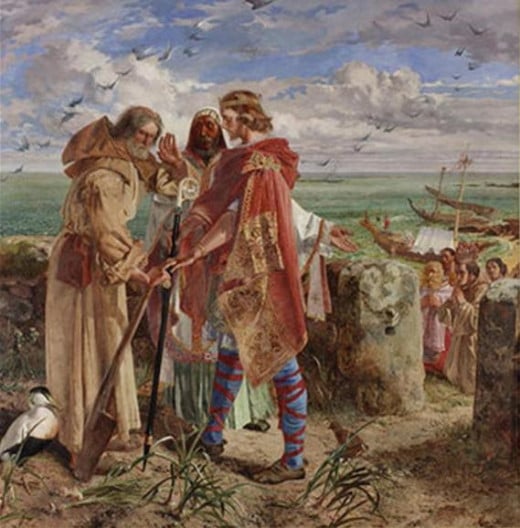
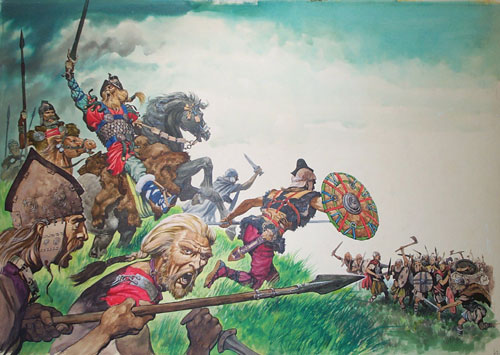


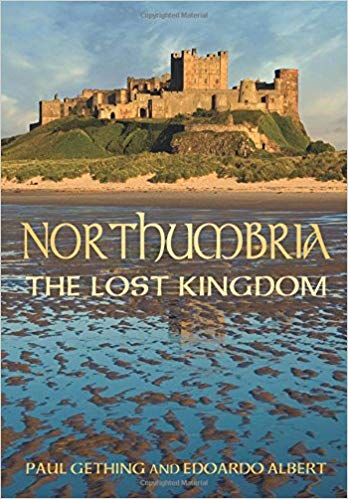
Another of the writer Edoardo Albert's works that features Northumbria and its kings. Why a 'Lost Kingdom'? Northumbria was effectively no longer a kingdom after the Danes' incursion in the 9th Century, when a puppet king was installed. After that the Anglian kingdom of Northumbria was reduced, now only north of the Tees and east of the Pennines. Deira became the Kingdom of York. When Aethelstan became king, Northumbria was further reduced in status to a satellite of Wessex before becoming an earldom under Knut less than fifty years later
St Wilfrid and Ripon (aet Hripum)

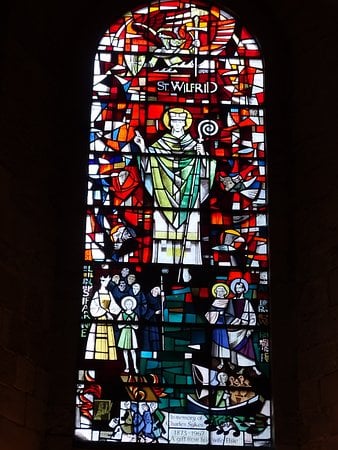
Aeldfrith and A New Dawn
Ecgfrith over-extended his boundaries taking on Brude, king of Caledonia. On May 20th, AD 685 He and a Northanhymbran army were beaten to a man, slain at Dun Nechtan - Nechtanesmere in Northumbrian annals - by a force that cornered and crushed them. For the time being we would see expansion halted. Cuthbert had warned him against going to Meath, he should have heeded the old man's counsel, reined in his ambition and consolidated his power.
The way was clear for a successor born the wrong side of the sheets from Edwy's liaison with a Gaelic princess. Aeldfrith was no great warrior leader but a man of learning who had grown to manhood across the Irish Sea. With Aeldfrith's succession Benedict Biscop completed his monastery at Jarrow, a brother house to that at Monkwearmouth. Amongst the intake of new talent was a lad of nine who had been sent from Monkwearmouth. The youngster would become known to historians as Bede. Unluckily for the Brothers at both sites an attack of the pestilence decimated their number. Amongst the survivors at Jarrow was the young Bede and Abbot Ceolfrith.
Cuthbert could see his time drawing in and withdrew from his post at Lindisfarena to live on the isle of Inner Farena as a hermit, dying in AD 686 with seabirds and seals for company. His passing was mourned the kingdom wide. Wilfrid would return to Northanhymbra to take up the reins of Bishop of Lindisfarena. Within a couple of years he would take over as Bishop of Hexham from John of Beoferleag (Beverley), who went to become a hermit in the manner of Cuthbert. Eadbert would take Wilfrid's place on Lindisfarena.
It did not take Wilfrid long to irk his fellows with his intransigence on matters ecclesiastical. Once again digging his heels in he opposed the creation of a new bishopric centred on Aet Hripum, and again he was ejected. John of Beoferleag took up the bishopric of Hexham and all would be quiet in the kingdom again... for now. The peace would be shattered in time, but for the time being Wilfrid founded several monastic houses in Mierca .during the interim, AD 691-703. In AD 693 an erstwhile pupil of Wilfrid's at Aet Hripum would be consecrated Bishop of the Frieslanders. A silver lining in the clouds would shine for Wilfrid when Aeldfrith died on December 4th, AD 705 in East Yorkshire.
Bede, a progress of intellect:
Against a backdrop of weak kings the Northanhymbran Church grew in importance. No ecclesiastical establishment stood out more than others than the twinned houses of Monkwearmouth and Jarrow. When Benedict Biscop succumbed to the palsy on January 12th, AD 690 Ceolfrith stepped into his shoes. A couple of years later Bede was ordained at the comparatively young age of nineteen as deacon, and as priest eleven years later in AD 703.
Bede was marked out as a leading light, lucky in being amongst well travelled and erudite Brothers, their outlook and views considered Ceolfrith was able to talk the monks of iona into adopting the Roman doctrine, a feat considering for them it would have gone against the grain and tested the faith of their adherents on the mainland. To any who even bothered to muse over it, Rome was remote, its Church irrelevant to Britain's needs.
At the foremost of our thoughts on Bede was his 'Historia Ecclesiastica' or 'History of the English Church and People'. Written relatively early in the development of the diverse nature of the competing kingdoms, the work introduced the reader to the origins of the Aengle, Jutae and Seaxne and where they settled on the mainland. He was very specific about the limitations and achievements of his own people, the Aengle, specifically the Northanhymbran Aengle amongst whom he had grown up, although he had to be fairly even-handed regarding the ethnic origins and achievements of the rival Miercan Aengle and West Seaxne.
It was also partly through him that the Pontiff in Rome raised the standing in AD 734 of the Bishopric of Eoferwic (Ebor) to an Archbishopric equal at least to that of Cantuarebyrig (Cantab). A pupil of Bede's, Ecgberht would be its first Archbishop - it would be several centuries later, at the time of Lanfranc in William I's reign, that Cantuarebyrig was elevated to senior status.. ,
Northanhymbra would mourn his passing at Jarrow a year later on May 25th, a man of high standards in learning, who had brought this seemingly obscure kingdom to the forefront of European awareness. The scholastic achievements of Jarrow and Monkwearmouth were a beacon.in the so-called Dark Ages.
Weak kingship rendered the good works of Oswald, Oswy and Ecgfrith meaningless. Rivalry between Beornica and Deira almost to collapse and subservient to the Miercan king Offa, who modelled himself on Charles the Great (Carloman or Charlemagne).
Next: NORTHUMBRIA - 3: THE BEACON DIMS - Decline,and Danes. .
Bede the historian and educator

© 2015 Alan R Lancaster
